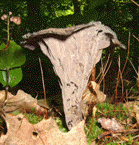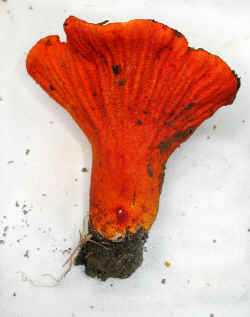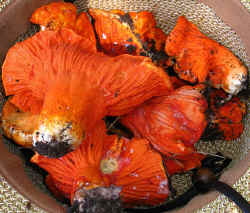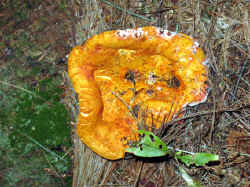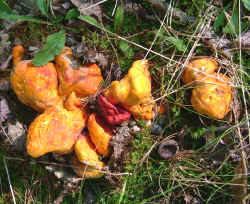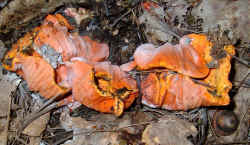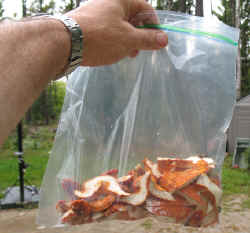|
|
A New England and Eastern Canada Edible and Medicinal Mushroom Resource |
||
|
You can see why this one is called lobster mushroom. It has a color similar to cooked lobster meat or lobster shell and can have a seafood-like aroma when cooking. It is actually an example of a mold attacking a mushroom. Hypomyces lactifluorum attacks and parasitizes Lactarius piperatus or Russula brevipes and covers the entire fruit body with an orange skin. Lactarius piperatus has a peppery flavor that is improved by Hypomyces. Russula, which is very crumbly, becomes dense and less breakable. Cap (pileus) Irregular often resembling the shape of the mushroom it attacks. Russula and Lactarius can develop a concave cap and the lobster may look somewhat like that. It can seriously deform the shape though and be very irregular. There are often cracks in the surface. The caps often collect dirt as they come out of the ground and cleaning them can be difficult. If the cap is cracked and dirt has collected in the cracks, it can rapidly spoil. One should not despair as it can be put to other good uses such as dyeing. Gills None Stem (stipe) Usually there is little to no stem. Flesh is white or slightly orangey white and quite dense Spores Colorless and difficult to collect. When and where to find them (ecology) These can be found under a variety of trees but hemlock is a good candidate. September and October seem to be the months when most will be found but they can appear as early as July. Any place where Lactarius, an exceedingly common mushroom that is white with a concave cap, grows, is a possibility. They are very noticeable. Nothing else looks remotely like them. Preparation: Lobster mushrooms can be highly variable in their flavor characteristics. Nice fresh specimens that are completely white on the interior are best. They can tend to have brown spots that should be trimmed off though. Plain preparation is a good choice. Clean young specimens will often have a seafood odor when you cook them that is a natural with lobster, crab, or other seafood. When sautéing or pan frying, it creates a lobster colored orange juice in the pan that can make your dish more festive and lobster-like. The flavor and aroma characteristics are ephemeral so be sure not overcook or the aroma will be lost. Tempura frying is very pleasant as well. Often they are delicious but older specimens can be somewhat mealy. Lobsters are a white wine mushroom. Mixing and matching with foods normally associated with white wine is best. Comments It has been postulated in some mushroom field guides that Hypomyces could attack a poisonous mushroom such as an amanita causing poisoning. There does not seem to be a lot of actual evidence of this. People have eaten this one for hundreds of years with few known incidents. As always, if you have never eaten a particular type of mushroom, try a small amount first. This one can be very choice or not so good in my experience. Often, older specimens can get rot spots from dirt sitting on the top or in crevices of the cap and start to smell bad. Don't give up if you find one that is not great. You could break it or slice it up and distribute it in locations where Russulas and Lactarius grow and hope for the best. Lobsters can be used for dyeing wool, some fabrics, or paper and will yield a cinnamon pink to red color with wool when ammonia is used as a mordant. I did not find many last year. Those I did find were not that good.
Find more information here:
Use of this site will constitute your acceptance of the disclaimer. Copyright 2011 Mushroom-Collecting.com. All rights reserved. |
